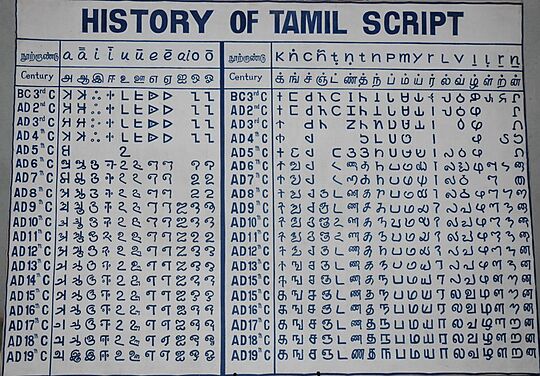Tamil language facts for kids
Quick facts for kids Tamil |
||||
|---|---|---|---|---|
| Tamiḻ தமிழ் |
||||
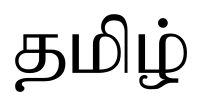
The word "Tamil" in the Tamil script
|
||||
| Pronunciation | [t̪amiɻ] | |||
| Native to | India and Sri Lanka | |||
| Region |
|
|||
| Ethnicity |
|
|||
| Native speakers | L1: 79 million (2011–2019)e27 L2: 8 million (2011) |
|||
| Language family |
Dravidian
|
|||
| Early forms: |
Old Tamil
|
|||
| Dialects |
Eelam
Malesiyat
Bunagurr
Iyengar
Kongu
Chennai
Madurai
Tiruneveli
Sankethi
Estate
Central
Malabar †
|
|||
| Writing system |
|
|||
| Official status | ||||
| Official language in |
|
|||
| Recognised minority language in |
|
|||
| Regulated by |
|
|||
| Linguist List | oty Old Tamil | |||
| Linguasphere | 49-EBE-a | |||
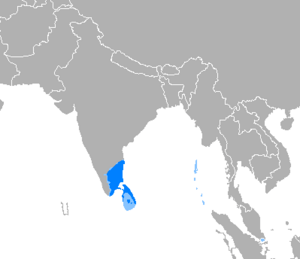 |
||||
|
||||
Tamil (pronounced like TAH-mil) is a very old language spoken by the Tamil people in South Asia. It belongs to the Dravidian languages family. Tamil is an official language in the Indian state of Tamil Nadu and the area of Puducherry. It is also an official language in the countries of Sri Lanka and Singapore.
Many Tamil speakers also live in other parts of India, like Kerala, Karnataka, Andhra Pradesh, Telangana, and the Andaman and Nicobar Islands. You can also find Tamil speakers all over the world, including Malaysia, South Africa, the United Kingdom, United States, and Canada. Even the Sri Lankan Moors speak Tamil.
Tamil is one of the 22 official languages listed in the Constitution of India. It was the first language in India to be called a "classical language." This means it has a very long and rich history. Experts say Tamil is one of the oldest languages still spoken today. Its literature has been around for over 2000 years! The earliest Tamil writings, called Sangam literature, date back to around 300 BC.
In 1578, a Tamil prayer book was printed by Portuguese missionaries. This made Tamil the first Indian language to be printed. The Tamil Lexicon, a dictionary, was also one of the first dictionaries published in Indian languages. In 2001, there were over 1,800 newspapers published in Tamil.
Contents
What is Tamil?
Language Family: Dravidian Languages
Tamil is part of the Dravidian languages family. This family includes about 26 languages spoken mainly in India. Tamil is also part of a smaller group called the Tamil languages. This group includes Tamil and languages spoken by about 35 other groups, like the Irula people.
The language most similar to Tamil is Malayalam. These two languages started to become different around the 9th century AD. They fully separated into their own languages by the 13th or 14th century.
Tamil's Long History

Like other Dravidian languages, Tamil comes from a very old language called Proto-Dravidian. This language was probably spoken around 3000 BC.
Tamil has the oldest non-Sanskrit literature in India. Scholars divide Tamil's history into three main periods:
- Old Tamil (300 BC–AD 700)
- Middle Tamil (700–1600)
- Modern Tamil (1600–present)
In 2007, ancient Tamil writings were found on Egyptian pottery from the 1st century BC. Some experts believe Tamil words might even be found in old Hebrew texts from before 500 BC. This shows how old the language is!
Archaeologists have found many ancient items in Tamil Nadu. About 60,000 of the 100,000 inscriptions found in India by the Archaeological Survey of India are in Tamil Nadu. Most of these are in Tamil. In 2004, skeletons were found in pots from around 696 BC in Adichanallur. Some of these pots had Tamil writings on them.
More recently, between 2017 and 2018, over 5,800 artifacts were found at the Keezhadi excavation site. Some of these items with Tamil writings are thought to be from around 580 BC.
The Legend of Tamil
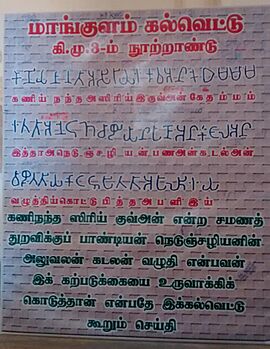
According to Hindu stories, the god Shiva created the Tamil language. The god Murugan, who is very important to Tamils, along with a wise man named Agastya, then shared the language with people.
What Does "Tamil" Mean?
The exact meaning of the name "Tamil" is not fully clear. However, the earliest writings about the language, like Tolkāppiyam (from around 2nd century BC), already use the name "Tamil."
Some scholars think "Tamil" comes from words meaning "self-speak" or "our own speech." Others suggest it means "unfolding sound" or "the proper way of speaking." The dictionary from the University of Madras says the word "Tamil" means "sweetness." Another idea is that it means "sweet sound."
Old Tamil: The Beginning
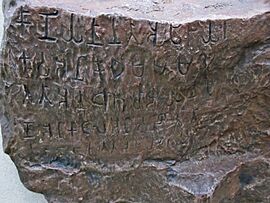
Old Tamil was spoken from about 300 BC to 800 AD. The earliest writings from this time are short messages carved into rocks. These were written in a special script called Tamil-Brahmi.
The oldest long text in Old Tamil is Tolkāppiyam. This book is about Tamil grammar and poetry. Many poems from this period, known as Sangam literature, have also survived. These poems are usually from between 1 BC and 5 AD.
Middle Tamil: Changes Over Time
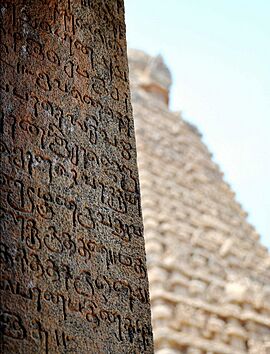
Middle Tamil developed from Old Tamil around the 8th century. During this time, the language changed in how it sounded and how its grammar worked. For example, the way to show the "present tense" in verbs appeared during this period.
Modern Tamil: Today's Language
The grammar rules for modern written Tamil are still based on Middle Tamil from the 13th century. However, the way people speak Tamil today is different. For example, people now use different ways to say "not" instead of the old verb forms.
When Europeans came to India, their languages like Portuguese, French, and English also influenced Tamil. Written Tamil started using punctuation like in European languages. The way sentences were built also became more complex.
In the early 1900s, a movement called the Pure Tamil Movement started. Its goal was to remove all words borrowed from Sanskrit from Tamil. This movement was supported by some political groups. Because of this, many Sanskrit words were replaced with Tamil words, especially in formal writing and speeches.
Where is Tamil Spoken?
Tamil is the main language for most people in Tamil Nadu and Puducherry in India. It is also widely spoken in the Northern and Eastern parts of Sri Lanka.
Smaller groups of Tamil speakers live in other Indian states like Karnataka, Telangana, Andhra Pradesh, and Kerala. Historically, Tamil was used a lot in Kerala for government and literature until the 12th century.
Many Tamil-speaking people live outside India and Sri Lanka because their ancestors moved there a long time ago. These communities are in places like Malaysia, Singapore, Mauritius, South Africa, and Myanmar. In Malaysia, Tamil is even used as a language for school education.
Today, many Tamils have also moved to countries like Canada, the United States, the United Arab Emirates, the United Kingdom, and Australia.
Tamil's Official Status
Tamil is an official language in Tamil Nadu and Puducherry in India. It is also one of the 22 official languages listed in India's constitution. Tamil is an official language in Singapore and one of the official and national languages of Sri Lanka.
In Malaysia, there are over 500 government primary schools where Tamil is the main language of teaching. In Canada, January has been named "Tamil Heritage Month" by the government. Tamil is also taught in schools in the KwaZulu-Natal province of South Africa.
In 2004, the Indian government officially recognized Tamil as the first "Classical language" of India. This was a big moment for the language and its speakers.
How Tamil Varies
Regional Differences in Tamil
Tamil has different ways of being spoken, called dialects. These dialects change depending on where people live. For example, the word for "here" sounds different in various parts of Tamil Nadu and Sri Lanka.
Even though dialects don't change the meaning of words much, there are some differences. For instance, Tamil spoken in Sri Lanka keeps many old words and grammar rules that are not used much in India.
Some dialects have also borrowed words from other languages. The Tamil spoken in the Palakkad area of Kerala has many words from Malayalam. Tamil spoken in Kanyakumari district has its own unique words and sounds.
Some groups of people, like certain castes, have their own ways of speaking Tamil. For example, Tamil Brahmins often speak a dialect that has softer sounds and more words borrowed from Sanskrit. Tamil in Sri Lanka has borrowed words from Portuguese, Dutch, and English.
Spoken vs. Written Tamil
Tamil has different styles:
- A very old, classical style (sankattamiḻ)
- A modern formal style used in writing (centamiḻ)
- A modern everyday spoken style (koṭuntamiḻ)
These styles blend into each other. For example, you can write in the formal style but use words from the classical style.
Today, the formal centamiḻ is used in textbooks, literature, and public speeches. However, the everyday spoken koṭuntamiḻ is becoming more common. It's used in movies, TV shows, and by politicians who want to connect with people.
In India, the "standard" spoken Tamil is influenced by the dialects of Thanjavur and Madurai. In Sri Lanka, the standard is based on the dialect of Jaffna.
How Tamil is Written

After the ancient Tamil Brahmi script, Tamil was written using other scripts like vaṭṭeḻuttu. The current Tamil script has 12 vowels, 18 consonants, and one special character. These combine to make 216 other characters, for a total of 247 characters.
In Tamil, all consonants have a natural "a" sound. To remove this sound and make a "dead consonant" (a consonant without a vowel), a small dot called a puḷḷi is added above the letter. For example, ன is "na," but ன் is "n."
The Tamil script does not show the difference between voiced (like 'b' or 'd') and unvoiced (like 'p' or 't') sounds for some letters. Instead, how a sound is pronounced depends on where it is in a word.
Sometimes, six extra characters from the Grantha script are used. These are for sounds not native to Tamil, often found in words borrowed from other languages like Sanskrit.
Tamil Numerals and Symbols
Tamil has its own unique numbers for 10, 100, and 1000. It also has symbols for things like day, month, year, debit, credit, and rupee.
| zero | one | two | three | four | five | six | seven | eight | nine | ten | hundred | thousand |
|---|---|---|---|---|---|---|---|---|---|---|---|---|
| ௦ | ௧ | ௨ | ௩ | ௪ | ௫ | ௬ | ௭ | ௮ | ௯ | ௰ | ௱ | ௲ |
| day | month | year | debit | credit | as above | rupee | numeral |
|---|---|---|---|---|---|---|---|
| ௳ | ௴ | ௵ | ௶ | ௷ | ௸ | ௹ | ௺ |
How Tamil Grammar Works
Building Words with Suffixes
Tamil grammar uses a method called "agglutination." This means that small parts, called "suffixes," are added to the end of words to change their meaning or show things like gender, number, or tense. For example, one long Tamil word can mean a whole sentence in English!
The oldest Tamil grammar book is Tolkāppiyam. Modern Tamil writing still follows rules from a 13th-century grammar book called Naṉṉūl, which explained the rules of Tolkāppiyam.
Tamil words are built from a main part (the root) and one or more suffixes. Suffixes can change a word's type (like from a noun to a verb) or add information (like who is doing the action or when it happened). There's no limit to how many suffixes can be added.
For example, the word pōkamuṭiyātavarkaḷukkāka (போகமுடியாதவர்களுக்காக) means "for the sake of those who cannot go." It's made of many small parts:
போக
pōka
go
முடி
muṭi
accomplish
ஆத்
āt
NEG.IMPRS
அ
a
PTCP
வர்
var
NMLZ
கள்
kaḷ
PL
உக்கு
ukku
to
ஆக
āka
for
Nouns and Verbs in Tamil
Tamil nouns (names of people, places, things) are divided into two main groups:
- Rational (uyartiṇai): This includes humans and gods.
- Irrational (akṟiṇai): This includes animals, objects, and ideas.
These groups are further divided into five classes, often shown by suffixes. For example, the word for "doer" changes based on who did it:
| peyarccol (Name-words) | ||||
| uyartiṇai (rational) |
aḵṟiṇai (irrational) |
|||
| āṇpāl Male |
peṇpāl Female |
palarpāl Collective |
oṉṟaṉpāl One |
palaviṉpāl Many |
| Example: the Tamil words for "doer" | ||||
| ceytavaṉ He who did |
ceytavaḷ She who did |
ceytavar(kaḷ) They who did |
ceytatu That which did |
ceytavai Those ones which did |
Tamil verbs also use suffixes to show who is doing the action, how many people are doing it, when it happened (past, present, future), and how the action is happening. For example, the word aḻintukkoṇṭiruntēṉ (அழிந்துக்கொண்டிருந்தேன்) means "(I) was being destroyed."
| அழி | ந்து | கொண்டு | இரு | ந்த் | ஏன் |
| aḻi | ntu | koṇṭu | iru | nt | ēn |
| root destroy |
transitivity marker intransitive |
aspect marker continuous |
aspect marker continuous |
tense marker past tense |
person marker first person, singular |
Tamil does not have words like "a," "an," or "the" (articles). The meaning is usually clear from the rest of the sentence. Also, in Tamil, the word for "we" can be different depending on whether it includes the person you are talking to or not.
Sentence Structure
In Tamil sentences, the verb usually comes at the end. The typical order is Subject-Object-Verb (SOV). For example, "I apple eat" instead of "I eat apple." However, the word order can be flexible to emphasize different parts of the sentence.
Tamil does not always need a subject, verb, and object in every sentence. For example, muṭintuviṭṭatu means "completed" and is a full sentence with just a verb. Also, Tamil doesn't have a word like "is." So, atu eṉ vīṭu means "That [is] my house."
Tamil Words and Their Origins
Most Tamil words come from the Dravidian language family. Modern Tamil tries to avoid using words borrowed from other languages. However, throughout history, Tamil has borrowed words from languages of neighboring groups or trading partners. These include words from Malay, Chinese, and Greek.
More recently, Tamil has borrowed words from Urdu and Marathi, and from nearby languages like Telugu, Kannada, and Sinhala. Words from European languages like Portuguese, French, and English have also been adapted.
Sanskrit has had a strong influence on Tamil, but Tamil has always been able to express complex ideas without needing many Sanskrit words. In the 20th century, the Pure Tamil Movement worked to remove Sanskrit words from Tamil. Because of this, the use of Sanskrit words in formal Tamil has greatly decreased.
Today, Tamil has a very large vocabulary, with over 470,000 unique words. In 2019, the government even added 9,000 new words to the language!
Tamil's Influence on Other Languages
Some words you might know actually come from Tamil or other Dravidian languages. For example:
- Orange: This word comes from a Dravidian word that means "fragrant fruit."
- Anaconda: Some believe this snake's name comes from a Tamil word meaning "having killed an elephant."
- Cheroot: From a Tamil word meaning "rolled up."
- Mango: From the Tamil word māṅgāy.
- Mulligatawny: From Tamil words meaning "pepper water."
- Pariah: From a Tamil word for a drum-beater.
- Curry: From the Tamil word kaṟi.
- Catamaran: From Tamil words meaning "bundled logs."
- Congee: From a Tamil word for "rice porridge."
Sample Text
Here is Article 1 of the Universal Declaration of Human Rights in Tamil. It talks about how everyone is born free and equal.
உறுப்புரை
Uṟuppurai
urupːurai
Section
1:
1:
ond̺rʉ
1:
மனிதப்
Maṉitap
mənid̪ə
Human
பிறவியினர்
piṟaviyiṉar
piriʋijinər
beings
சகலரும்
cakalarum
səgələrum
all-of-them
சுதந்திரமாகவே
cutantiramākavē
sud̪ən̪d̪irəmaːgəʋeː
freely
பிறக்கின்றனர்;
piṟakkiṉṟaṉar;
pirəkːin̺d̺ranər
are born.
அவர்கள்
avarkaḷ
əvərgəɭ
They
மதிப்பிலும்,
matippilum,
məd̪ipːilum
rights-in-and
உரிமைகளிலும்
urimaikaḷilum
uriməigəɭilum
dignities-in-and
சமமானவர்கள்,
camamāṉavarkaḷ,
səməmaːnəʋərgəɭ
equal-ones.
அவர்கள்
avarkaḷ
əvərgəɭ
They
நியாயத்தையும்
niyāyattaiyum
nijaːjatːəijum
law-and
மனச்சாட்சியையும்
maṉaccāṭciyaiyum
mənətt͡ʃaːʈt͡ʃijəijum
conscience-and
இயற்பண்பாகப்
iyaṟpaṇpākap
ijərpəɳbaːgə
intrinsically
பெற்றவர்கள்.
peṟṟavarkaḷ.
pet̺rəʋərgəɭ
possessed-ones.
அவர்கள்
Avarkaḷ
əvərgəɭ
They
ஒருவருடனொருவர்
oruvaruṭaṉoruvar
oruʋəruɖənoruʋər
among-one-another
சகோதர
cakōtara
sagoːdəɾə
brotherly
உணர்வுப்
uṇarvup
unərʋɨ
feeling
பாங்கில்
pāṅkil
paːŋgil
share-in
நடந்துகொள்ளல்
naṭantukoḷḷal
nəɖən̪d̪ʉkoɭɭəl
act
வேண்டும்.
vēṇṭum.
veːɳɖum
must.
Article 1: All human beings are born free and equal in dignity and rights. They possess conscience and reason. Therefore, everyone should act in a spirit of brotherhood towards each other.
Images for kids
See also
 In Spanish: Idioma tamil para niños
In Spanish: Idioma tamil para niños
- List of countries where Tamil is an official language
- List of languages by first written accounts
- Tamil keyboard
- Tamil population by cities
- Tamil population by nation
- Tamil Loanwords in other languages
- Tamil Shorthand



